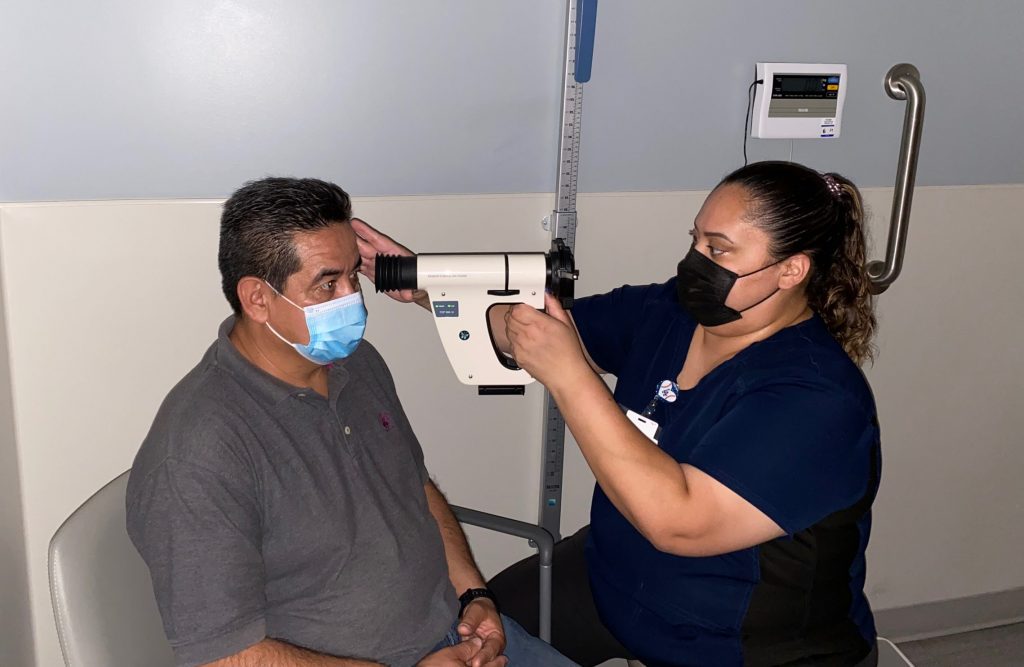Diabetic Retinopathy Screeners: How Teleretinal Imaging Can Help Prevent Blindness

Diabetic retinopathy is a common development in patients with diabetes. High blood sugar levels can cause damage to blood vessels in the retina, which can lead to swelling and leaking, more specifically known as diabetic retinopathy. This disease is often asymptomatic but can cause symptoms like blurry vision, floaters, distorted vision, and blank or dark areas in your field of vision.
After a diabetic retinopathy diagnosis, treatments vary by severity and can include medically controlling a patient’s blood sugar and blood pressure, medicine, laser eye surgery, injections, or a vitrectomy (a surgery to remove some or all vitreous humor, a substance that fills the back of your eye).
Diabetic Retinopathy: Prevalent, Yet Preventable
The good news is that diabetic retinopathy is very preventable if caught and treated early. Disproportionate to how treatable diabetic retinopathy is, the rate of the disease amongst diabetic adults in the US over 40 is 28.5%, meaning around 4 million Americans are suffering from this illness.
Partially contributing to this number is the fact that the vast majority of diabetic patients who develop diabetic retinopathy have little to no symptoms until the late stages of the illness, at which point treatment is more expensive and invasive. Therefore, identifying it early and crafting a treatment plan is of the utmost importance in fighting the battle against preventable blindness, which means that regularly screening patients for diabetic retinopathy is crucial to maintaining overall health.
Using a Diabetic Retinopathy Screener or Fundus Camera to Help Identify Diabetic Retinopathy
Diabetic retinopathy screeners, also known as fundus cameras, can help save many people from going blind by providing a new way to diagnose diabetic retinopathy in the early stages. Screening for retinopathy is clearly beneficial, according to this study, for those who have high-risk macular edema, proliferative retinopathy, or those who could reduce their loss of vision long-term with early detection.
Not to mention, the American Diabetes Association updated its guidelines to recommend screening timelines for individuals who could run the risk of developing diabetic retinopathy to match the sentiments of this study.
So what can you do to help prevent this disease from impacting more individuals? The best thing health care providers can do is to increase the ease with which patients receive diabetic retinal exams.
IRIS: The Complete Teleretinal Imaging Solution for Diabetic Retinopathy
Fortunately, modern technology like the IRIS solution has advanced so far as to allow general practitioners to offer retinal imaging services in their office. Instead of a patient having to schedule a separate screening appointment with an eye care specialist, they can simply receive the exam during a regular doctor appointment. Because this option makes it so convenient to perform screenings, it makes a drastic difference in the number of individuals who get regular screenings.
In fact, IRIS software is compatible with most fundus cameras, allowing clients the ability to choose the equipment that makes the most sense from a financial and usability standpoint. IRIS comes with the ability to leverage the IRIS Reading Center (IRC), which is a group of board – certified eye care providers who remotely diagnose retinal images and identify signs of diabetic retinopathy. When using the IRC, IRIS clients can expect quick and accurate results. Since the very first IRIS exam, there have been over 105,000 “IRIS Saves”, or catches of moderate, severe, or proliferative diabetic retinopathy that if left untreated would almost certainly result in the patient losing their vision.
IRIS technology has already made a vast difference in groups like the American Health Network (AHN), which counts 27,000 diabetic patients amongst its population. In 2016, half of these patients were not attending annual diabetic retinopathy exams and doctors found little success in referring patients to ophthalmologists. The AHN found its solution in IRIS’s simple patient exam experience with diagnostic capabilities. Since implementation, multiple AHN payer contract offices are trending above 90% total compliance in preventative measures for diabetic retinopathy.
See yourself and your practice benefitting from this amazing healthcare solution? Sign up for a demo today and see how easy it can be to implement technology that can help identify disease both quickly and effectively.

FAQ’s
Is diabetic retinopathy reversible?
There are advanced treatment plans for diabetic retinopathy and sometimes the disease can be prevented from progressing, but as of today, there is no true cure. A patient’s best bet is to make sure they are taking the best preventative measures they can and getting yearly diabetic retinopathy screening.
Is diabetic retinopathy progressive?
Yes. The issue is that the first few stages of diabetic retinopathy are relatively symptomless unless a patient undergoes diabetic retinopathy screening. Making screenings as easy as possible for patients to attend is the best way to ensure that this disease does not progress quickly to vision-threatening stages.
SM075 Rev A
Get started with IRIS today.
Want to know if IRIS is right for you? Schedule a one-on-one consultation with our team. We’re here to help.